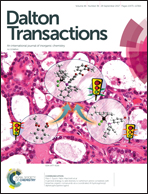Synthesis and characterisation of new tripodal lanthanide complexes and investigation of their optical and magnetic properties†
Abstract
This paper presents the synthesis of a tripodal ligand (H3L) via the Schiff base condensation of N,N-diethylsalicylaldehyde and tris(2-aminoethyl)amine. The neutral complexes of type [EuL], [GdL] and [DyL] were synthesized and characterized by FT-IR, SEM-EDS, PXRD, single crystal X-ray diffraction, CHN analysis and high resolution ESI-MS. X-ray crystallographic studies demonstrated that the heptadentate ligand incorporating a cavity pre-organized by hydrogen bonding binds the Ln(III) ions to yield a face capped octahedral coordination geometry with three-fold symmetry. Photoluminescence studies show a typical Ln(III) absorption character for the three complexes, with [EuL] demonstrating considerably stronger lanthanide-based luminescence peaks, and a Eu(III) centered luminescence lifetime of 0.144 ± 0.01 ms. Temperature/field-dependent DC and temperature/frequency-dependent AC magnetic measurements carried out for the Dy(III) complex indicated obvious magnetic anisotropy and suggested slow relaxation behaviour with considerable quantum tunnelling of the magnetization contribution.



 Please wait while we load your content...
Please wait while we load your content...